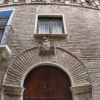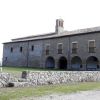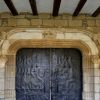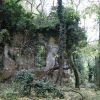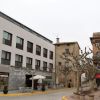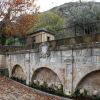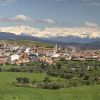Located between the mountains and the riverbank of the eastern reaches of Somontano, Estadilla boasts a variety of attractions.
The name of the village is derived from the Latin word stata (stop) making reference to its remote Roman origins. It sprang up during the first centuries of our era next to one of the many secondary roads that were used to link the Ebro valley with the Pyrenees.
Today it is the departure point for a multitude of destinations but is also the ideal spot for enjoying wild yet welcoming nature. It has retained an interesting ancestral culture that is tangible; Baixo Ribagorzano is the name given to the local dialect that is still used by many villagers.
The landscape that surrounds the village hides many contrasts awaiting discovery. To the west lie the banks of the River Cinca and flat and fertile lands peppered with fruit trees, olive trees, almond trees, vines and cultivated crops. To the north there are lush vegetable gardens, irrigated from the spring waters of the village fountain. The east reveals the dramatic mountain formations of the Carrodilla range where caves and gorges are a result of the karstic phenomena.
The limestone rock in the Sierra de la Carrodilla is susceptible to the erosive effect of the water as it filters through the rock, sculpting a number of distinctive features on the surface as well as underground. These include the canyons of Chardiz, la Chunquera, Santacum and Las Covas, the underground abyss known as Las Gralleras, caves such as Aigua, la Bruja, Alonsé, La Val, and La Sierra de Periz and springs such as Mentirosa where the water re-emerges from this underground network.
The peak of Buñero, with slopes coved in holm oak and Portuguese oak, reaches a height of 1108 metres. It is a magnificent viewpoint over the surrounding valleys of Cinca and Ésera, the Pyrenean peaks of Ribagorza and Sobrarbe and the mountain ranges of Guara and Somontano.
Holm oak, oak, juniper and a great variety of aromatic and rupicolous plants dress the slopes of these mountain ranges and provide the perfect environment for the much sought after truffle.
Soaring in the skies close to the village are the Crag Martin, Egyptian Vulture, Griffin Vulture and even the rare Lammergeyer and an exceptional display of butterflies can be found in the Chardiz Canyon.
Estadilla’s proud history reveals that it was once the location of a medieval defensive fortress (statella), which had a strategic role in the control of the left bank of the River Cinca. At the end of the 9th century the village was conquered by Aragonese troops after years of Muslim domination and between then and the 13th century was free of direct rule. However in 1260 this changed and its future fate was controlled by the powerful Baron of Castro, a man of a strong lineage that was linked to the Catalan and Aragonese nobility.The old town that we see today grew beneath the shadow of the old castle, of which hardly anything remains. The arcaded main square is home to a number of noble ancestral homes such as Casa Marro, Casa Sangenis and Casa del Barón as well as the Town Hall, a Renaissance building built in the style of a 16th century Aragonese palace.



